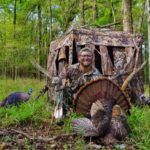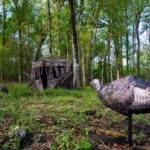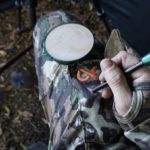
Turkey hunting is tough enough with a shotgun, but if you really want to increase the challenge, break out the sticks and string. Here’s what you need to know to bowhunt gobblers.
Harmon Carson will tell you that turkeys are smarter than you think. He should know — he’s been chasing them from Louisiana to Texas since he was in high school.
While he’s harvested his fair share of toms over the years, the 30-year-old from Haughton wanted more of a challenge — so he decided to pick up his bow.
“I’ve chased them all over with my bow,” he said. “But I haven’t killed many because they are a tough animal to bowhunt.”
A turkey’s keen eyesight means it can pick up even the slightest movement, which sends it running for safety. While most turkey hunters avoid detection by remaining still at the base of a tree with shotgun propped up and waiting, a bowhunter must move in order to draw back. For that reason, Carson said there’s no room for error.
While he’s harvested a few birds in Texas, it wasn’t until last year he was able to knock one down in Louisiana with his archery gear — with a long bow, to top it off. From a ground blind, he shot a nice tom from a distance of 16 yards. For him, bowhunting turkeys isn’t about filling tags — but rather about the challenge of it all.
“In 2011, I stopped using a compound and went straight traditional — for deer and everything,” he said. “I like the challenge of having to get the animal close. It’s much more intimate.”
Chad Lafleur, an Opelousas hunter who chases turkeys near Roxie, Mississippi, said it’s about the challenge, as well. He harvested his first gobbler with a bow about 18 years ago and since then, he said he’s only bagged a few more — a testament to the tough nature of bowhunting for turkeys.
“I’ve hunted turkeys in Nebraska, but our birds here are fewer and harder to hunt,” he said. “To me, killing one bird with a bow is more of an accomplishment than killing a limit with a shotgun.”
The right gear
The good news is that you can use the same bow to hunt turkeys as you do for deer. However, with turkeys, the goal isn’t a complete pass through. Instead, hunters are looking to keep an arrow stuck in the bird, which prevents it from flying off. While some will lower the poundage of their bow, Lafleur said he keeps his set to 70 pounds. But to slow the kinetic energy of his arrows, he uses expandable broadheads with at least a 2-inch cut.
“Just the feathers on the bird or the wing bone will also stop that arrow before it punches out the other side,” he said. “Last year, I put an arrow in a bird at 12 yards, and it went through the wing butt and into the chest cavity, but it didn’t get more than about 3 to 4 inches of penetration.”
Carson won’t drop his poundage, either, and opts for a large fixed-blade. His go-to is the cut-on-contact Tree Shark, a 190-grain head made by Simmons Sharks. “The reason I like that blade is the concave design,” he said. “When it goes in, you will have an entry and exit wound that is 50 percent bigger than the broadhead. It puts turkeys down quick.”
Although Lafleur carries a slate call in the woods, he seldom uses it. He said a diaphragm is a must for hands-free operation. When a turkey is within shooting range, there’s no time to reach for a call, but he’s easily able to emit a few soft purrs with a diaphragm to further entice a gobbler.
Concealment
When Carson is chasing turkeys with his shotgun, he sits at the base of the tree, and that’s usually enough. But with his bow, he prefers to use a ground blind because it helps keep him concealed as he’s drawing back.
If he has patterned a few gobblers with the help of game cameras, he’ll set up his ground blind where they’re known to hang out and wait for them to show up. His decoys and calling do most of the work.
“Normally, I put the hen close to me facing away and put my jake a little farther out facing toward me,” he said. “Normally the toms are going to approach another tom straight on. I want birds to come in right on top of the decoys. Even if a bird hangs up, you increase your chances of them being in bow range.”
If he hasn’t patterned any turkeys, he starts his hunt before first light with locator calls. That helps him to pinpoint the location of a gobbler so he can get an idea of where to spend the morning. By the time the sun rises, he’s set up with the same decoy tactic.
“Turkeys don’t mind ground blinds,” he said. “I set them up that same morning and they aren’t bothered by it like deer.”
Lafleur keeps his blind at home after opening weekend. He’s found the birds are more dispersed on the property he hunts as hunting pressure increases. So remaining mobile has been his ticket to success. He prefers to stay light and use the terrain to keep him concealed.
“Typically, I use a large tree to block the turkey’s view,” he said. “I set up to where I can see the bird coming and let it cross behind a tree. It’ll give me time to draw and once he comes out, I can shoot.”
Lafleur uses decoys to lure the toms in exactly where he wants them. If they’re focused on a decoy, he said they’re not looking at him.
“I always use a jake with a hen,” he said. “Most of the time, even a 2-year-old bird is going to be focused on that jake. I never use a full strut decoy because I’ve had too many birds get spooked by it. Even mature birds don’t want to interact with that.”
But he doesn’t set up too close to the birds’ roost so that he doesn’t spook them. “Decoys are a must,” he said. “If you’re not using one, a bird could be 15 yards off to your right and you’d never be able to turn to get a shot.”





